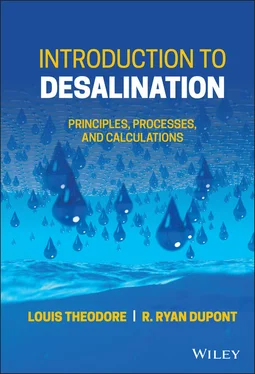Usable water is the key to sustainable life. However, out of all the water on Earth today, it is estimated that only 2.5 to 3.0% is usable. That still is quite a large amount of water, considering the Earth’s total global water supply is over 1.39 billion km 3. However, when one delves deeper into this estimated usable supply, it is found that a little over 0.3% of the usable water on Earth is easily accessible (Gleick 1996). This usable water is found in rivers, streams, lakes, and swamps. With the ease of access to these forms of usable water being so high, it is estimated that over 50% of the world’s population lives within 3.0 km of these surface water sources (Kummu et al. 2011). The majority of the available water that is not considered easily accessible is found in ground or subsurface water in natural aquifers.
Natural aquifers are the most common forms of groundwater storage. Today, these natural aquifers are thought to hold roughly 34.2 million km 3of total water. Out of these 34.2 million km 3of water, it is estimated that close to 10.4 million km 3of this water is usable (Gleick 1996). Since these aquifers are below the surface of the Earth, they do require the construction of wells for water recovery. These wells can range from tens to hundreds of feet deep, depending on where the water table is located. It is also important to note that these wells will generally require the installation of a pumping system to bring the water to surface. Table 1.2provides a comparison between the total water on Earth to the amount that is both groundwater and fresh-groundwater.
Table 1.2 Fresh groundwater, total groundwater, and total global water resources.
| Water source |
Water volume, mi 3 |
Water volume, km 3 |
% of Total water resource |
% of Total fresh water resource |
| Fresh groundwater |
2,526,000 |
10,530,000 |
0.80 |
30.1 |
| Total groundwater |
5,614,000 |
23,400,000 |
1.7 |
|
| Total global water resource |
332,500,000 |
1,386,000,000 |
|
|
As small as the ratio of total volume of usable water to unusable water is in the world, there are still considerable amounts of usable water resources present among the seven continents. The amount of usable water on each continent can be divided among the three water categories as just described earlier, i.e. groundwater; glacier/permanent ice caps; and surface water (i.e. wetlands, lakes, reservoirs, and rivers). These categories, along with the volumes of water in each for each continent across the globe are summarized in Table 1.3.
Table 1.3 Global water resources by continent (Modified from Rekacewicz 2006).
| Continent |
Glacier & permanent ice caps, km 3 |
Groundwater, km 3 |
Wetlands, large lakes, reservoirs & rivers, km 3 |
Totals, km 3 |
Total usable water resource, km 3 |
| North America |
90,000 |
4,300,000 |
27,003 |
4,427,003 |
4,327,003 |
| South America |
900 |
3,000,000 |
N/A |
3,00,900 |
3,000,000 |
| Europe |
18,216 |
1,60,000 |
2,239 |
1.620,745 |
1,602,529 |
| Africa |
0 |
5,500,000 |
31,776 |
5,531,776 |
5,531,776 |
| Australia |
180 |
1,200,000 |
221 |
1,200,401 |
1,200,221 |
| Asia |
60,984 |
7,800,000 |
30,622 |
7,891,606 |
7,830,622 |
| Antarctica |
30,109,800 |
N/A |
N/A |
30,109,800 |
0 |
On examining Table 1.3it becomes immediately obvious that Antarctica has by far the largest amount of fresh water of any continent. However, this fresh water is in the form of glaciers and permeant ice caps, thus making it unusable. When comparing usable water resources, the top three continents are Asia, with roughly 7,830,622 km 3of water, Africa, with approximately 5,531,776 km 3of water, and North America, with 4,327,003 km 3of total usable water resources. Furthermore, these three continents contain over 75% of the usable water on Earth. With this large amount of water being contained in three of the seven continents, mankind has adapted through the development of artificial reservoirs. These artificial reservoirs are most commonly constructed by the creation of a dam around an existing natural water source. Today, it is estimated that there are more than 515,000 of these man-made reservoirs of greater than 2.5 ac in size that cover roughly 258,000 km 2of the Earth’s surface (Osborn 2019).
Table 1.4summarizes the annual renewable fresh water resources for the top 25 countries in the world. Renewable fresh water resources are an estimate of the average precipitation, recharged groundwater, and fresh surface inflows from surrounding countries that each of these countries receives in any given year. What is interesting to note from these data is that despite a country having a great deal of renewable fresh water resources, water shortages and unequal distribution of resources can still take place. Consider Brazil, which tops the list with over 8,233 km 3of renewable fresh water each year. Despite what would appear to be an abundance of fresh water, Brazil is experiencing a long-term water crisis caused by poor water infrastructure and water resource management which has left over 5 million, or more than 2% of its citizens without access to safe potable water ( Water.org2019).
Table 1.4 Renewable annual fresh water resources for top 25 countries (Table 1.4 Advameg, Inc. 2010).
| Rank |
Country |
Total fresh water renewable resource, km 3 |
| 1 |
Brazil |
8,233 |
| 2 |
Russia |
4,498 |
| 3 |
Canada |
3,300 |
| 4 |
United States |
3,069 |
| 5 |
Indonesia |
2,838 |
| 6 |
China |
2,830 |
| 7 |
Colombia |
2,132 |
| 8 |
Peru |
1,913 |
| 9 |
India |
1,908 |
| 10 |
Democratic Republic of the Congo |
1,283 |
| 11 |
Venezuela |
1,233 |
| 12 |
Bangladesh |
1,211 |
| 13 |
Burma |
1,046 |
| 14 |
Chile |
922 |
| 15 |
Vietnam |
891 |
| 16 |
Republic of the Congo |
832 |
| 17 |
Argentina |
814 |
| 18 |
Papua New Guinea |
801 |
| 19 |
Bolivia |
622 |
| 20 |
Malaysia |
580 |
| 21 |
Philippines |
479 |
| 22 |
Cambodia |
476 |
| 23 |
Mexico |
457 |
| 24 |
Ecuador |
432 |
| 25 |
Japan |
430 |
Even in what is considered a highly advanced country like the United States, which receives 3,069 km 3a year of renewable fresh water and has historically invested in water infrastructure as well as the management of its water resources, it is estimated that as of 2014, 1.6 million people (0.5% of its population) were without a toilet, a tub or shower, or running water (UNC Environmental Finance Center 2017). Despite availability of renewable fresh water resources, equitable and affordable supply and access to these resources remain a significant challenge, particularly to minority and low-income communities, even in the most developed countries in the world.
Figure 1.1 summarizes the total per capita water consumption (consumption of surface or groundwater for domestic, commercial and industrial purposes; water for crop production; and water required for the assimilation of pollutants produced from domestic, commercial, and industrial activities) for the select countries in the world whose daily consumption is above and below the global average (Mekonnen and Hoekstra 2011). The global average for total per capita daily water usage is roughly 1,000 gal/capita/d (Grace Communication Foundation 2019). This is water that is used for domestic purposes such as laundry, cooking, drinking, washing, etc., as well as water used for food production, and the production of consumer goods, like cars, plastic bags, clothing, etc. At the top of this list with 2,270 gal/capita/day is the United Arab Emirates, 76% of which is associated with products or ingredients of consumer goods imported annually into the UAE (virtual water). In the United States, of the 2,200 gal/capita/day of total water use, only 20% is associated with imported external water consumption. The significant differences seen in the daily internal versus external per capita total water consumption are directly attributed to the consumption habits of each country’s citizenry.
Читать дальше












